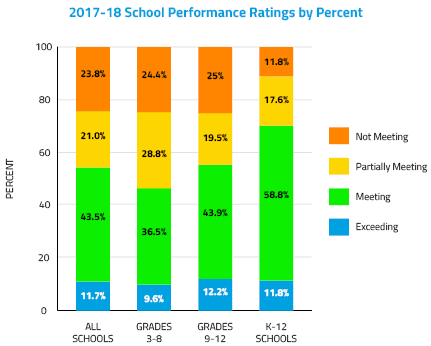CHEYENNE – The Wyoming Department of Education (WDE) has released school accountability results for the 2017-18 school year. Full results are available online.
“We set a high bar for schools with our accountability system, and my hope is that this information is a catalyst for discussions at the local level on how our schools can continue to do their best for all students,” said State Superintendent of Public Instruction Jillian Balow. “This year marks significant changes to accountability in Wyoming. Results include information from a new assessment system, incorporate changes to how we measure whether a student is ready for life after high, and focus on specific students groups, including students learning the English language. Today we step away from looking just at test scores to determine how well our schools are performing.”
The accountability results reflect the requirements of both state and federal law. Under state law, all Wyoming elementary, middle, and traditional high schools receive one of four School Performance Ratings: Exceeding Expectations, Meeting Expectations, Partially Meeting Expectations, or Not Meeting Expectations. The School Performance Ratings show that 55.2 percent of Wyoming schools are Meeting or Exceeding Expectations.

 |
Alternative high schools do not have School Performance Ratings for the 2017-18 school year, as it was the final pilot year for alternative school accountability. School Performance Ratings for alternative high schools will be available beginning in the fall of 2019.
Federal law requires the schools that are struggling the most be identified for support. There are three types of support:
- Comprehensive Support and Improvement (CSI) is for Title I schools performing among the lowest in the state and any school with a graduation rate below 67 percent.
- Targeted Support and Improvement (TSI) is for schools that have a specific group of students that is not performing well.
- Additional Targeted Support and Improvement (ATSI) is for schools that have a specific group of students that is chronically not performing well.
Under federal accountability, 21 schools were identified for Comprehensive Support and Improvement, 34 schools were identified for Targeted Support and Improvement, and two schools were identified for Additional Targeted Support and Improvement.
Changes in both state and federal law have impacted the measures used for accountability. Both now include the progress of students learning the English language and high schools factor in career readiness, along with college readiness. Additionally, WY-TOPP results were used to inform the accountability results.
Superintendent Balow added that these results show how the state and federal requirements can work together to provide greater insight into the health of education in Wyoming. “This information helps us to see which schools are performing the best and which schools need support to better serve their students. This important work is paramount to transparency and ultimately to improving our schools.”
-END-
Media Contact:
Kari Eakins, Communications Director
kari.eakins@wyo.gov
307-777-2053






